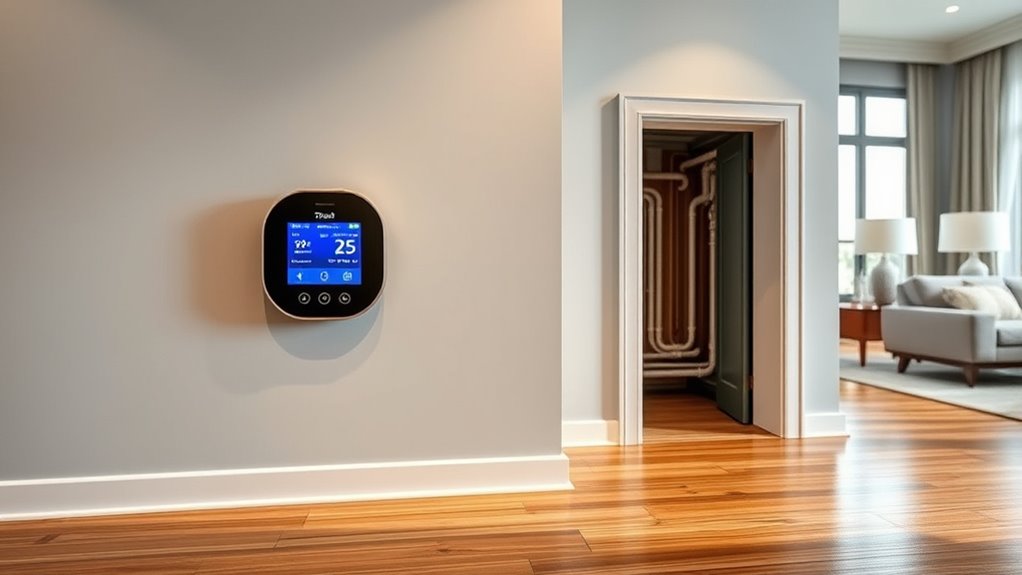Smart thermostats and geothermal systems can markedly boost the energy efficiency and comfort of your high-end home. They optimize heating and cooling with advanced controls, adapt to your habits, and reduce utility bills over time. Proper zoning and professional installation are key to maximizing benefits and avoiding uneven temperatures. If you want to discover how these innovative solutions can improve your home’s performance and value, there’s more to explore.
Key Takeaways
- Smart thermostats optimize energy use by learning occupant habits and adjusting temperatures automatically.
- Geothermal systems provide efficient, eco-friendly heating and cooling with low operational costs in high-end homes.
- Proper zoning with advanced controls ensures consistent comfort and reduces energy waste across multiple home areas.
- Initial installation costs are higher but offset by long-term savings and potential tax incentives.
- Integrating smart controls with geothermal systems maximizes energy efficiency and enhances home value.

Are you looking for a way to boost your home’s energy efficiency while saving money? Smart thermostats and geothermal systems are excellent solutions, especially in high-end homes where comfort and sustainability matter. These technologies work together to maximize your energy use, reducing waste and lowering your utility bills. However, before diving in, it’s essential to understand some potential challenges, like zoning issues and installation costs.
Zoning challenges can be a significant consideration when installing smart thermostats and geothermal systems. High-end homes often feature multiple levels, separate rooms, or distinct living areas, each with unique heating and cooling needs. Proper zoning allows you to control these areas independently, increasing comfort and efficiency. But integrating zoning into your system can be complex. It requires additional sensors, dampers, and controls, all of which need careful planning and design. If not managed well, zoning issues can lead to uneven temperatures or increased energy consumption, negating some of the benefits of smart management. Working with experienced professionals helps ensure zoning challenges are addressed effectively, giving you precise control over every part of your home.
Zoning issues can disrupt comfort and efficiency if not properly managed in high-end homes.
Installation costs are another critical factor. Geothermal systems, in particular, involve installing underground loops that exchange heat with the earth, which can be costly upfront. The installation process may require extensive excavation, land assessment, and specialized equipment, all contributing to higher initial expenses. Smart thermostats, on the other hand, tend to be more affordable but still involve costs for purchase and professional setup, especially in homes with complex HVAC configurations. While these investments can seem steep at first, the long-term savings on energy bills often outweigh the initial costs. Lower energy consumption, increased comfort, and potential tax incentives or rebates make these upgrades financially worthwhile over time.
Despite the upfront investments, the combination of smart thermostats and geothermal systems delivers remarkable energy efficiency. They adapt to your habits, learn your schedule, and adjust settings automatically, ensuring perfect comfort without wasting energy. In high-end homes, where occupants expect seamless control and sustainability, these systems shine. Just keep in mind that a thorough assessment of your home’s layout, zoning needs, and budget is essential. Proper planning can minimize installation surprises and ensure you get the most out of your investment. Additionally, understanding sound recording techniques and equipment can help ensure your system runs smoothly and quietly, enhancing overall comfort.
Frequently Asked Questions
How Do Smart Thermostats Learn Homeowner Preferences Over Time?
Smart thermostats use learning algorithms to track your user behavior over time. They analyze patterns in your temperature adjustments, occupancy, and routines, gradually understanding your preferences. With each interaction, they adapt to optimize comfort and efficiency. As you go about your day, the thermostat refines its settings based on your habits, ensuring your home stays comfortable while reducing energy waste without you having to manually set temperatures constantly.
Are Geothermal Systems Suitable for All Climate Zones?
You’re asking if geothermal systems fit every climate zone, and the answer is, it’s not a one-size-fits-all. While they excel in moderate climates, their regional efficiency diminishes in extremely cold or hot areas. However, climate adaptability varies based on installation and technology. You should evaluate regional factors and consult experts to determine if geothermal energy offers the best balance of efficiency and sustainability for your specific climate zone.
What Are the Typical Installation Costs for Geothermal Heating?
The typical installation costs for geothermal heating range from $10,000 to $30,000, depending on your property’s size and site conditions. You should do a thorough cost analysis, factoring in potential energy savings over time. Be aware of installation challenges, like drilling and land excavation, which can influence costs. While upfront expenses are high, geothermal systems often pay off through long-term energy efficiency and lower utility bills.
How Do Smart Thermostats Integrate With Existing Home Automation Systems?
Imagine your home as a symphony; smart thermostats seamlessly integrate with your existing home automation systems, creating harmony. They connect through Wi-Fi or wired protocols, ensuring smart home compatibility. User interface design makes control intuitive, allowing you to manage temperature settings effortlessly from your smartphone or voice commands. This integration enhances comfort and efficiency, transforming your home into a smart sanctuary where technology and comfort dance in perfect sync.
What Maintenance Is Required for Geothermal Heat Pump Systems?
You’ll need to perform regular maintenance like checking filters, inspecting antifreeze levels, and cleaning the compressor to keep your geothermal system running smoothly. Routine upkeep helps extend the lifespan of your geothermal system and reduces maintenance costs. Conduct a maintenance cost analysis annually to catch issues early, ensuring efficiency and preventing costly repairs. Proper care keeps your system reliable, energy-efficient, and prolongs its functional life.
Conclusion
By choosing smart thermostats and geothermal systems, you’re not just upgrading your home’s energy efficiency—you’re transforming it into a powerhouse of sustainability that could save you thousands and drastically reduce your carbon footprint. Imagine a future where your high-end home runs so efficiently, it practically pays for itself while making Mother Earth breathe easier. Make this leap now, and watch your home become a beacon of innovation and environmental responsibility—your smartest investment yet.









